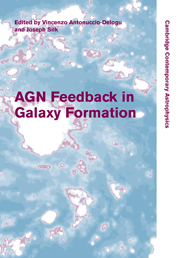Book contents
- Frontmatter
- Contents
- List of contributors
- Preface
- The organising committees
- Part I AGNs, starbursts and galaxy evolution
- Part II Co-evolution of black holes and galaxies
- Part III Outflows and radio galaxies
- Part IV Models and numerical simulations: methods and results
- 12 Physical models of AGN feedback
- 13 Large-scale expansion of AGN outflows in a cosmological volume
- 14 Relativistic jets and the inhomogeneous interstellar medium
- 15 AGN feedback effect on intracluster medium properties from galaxy cluster hydrodynamical simulations
- 16 Physics and fate of jet-related emission line regions
- 17 Cusp–core dichotomy of elliptical galaxies: the role of thermal evaporation
- Index
17 - Cusp–core dichotomy of elliptical galaxies: the role of thermal evaporation
from Part IV - Models and numerical simulations: methods and results
Published online by Cambridge University Press: 10 November 2010
- Frontmatter
- Contents
- List of contributors
- Preface
- The organising committees
- Part I AGNs, starbursts and galaxy evolution
- Part II Co-evolution of black holes and galaxies
- Part III Outflows and radio galaxies
- Part IV Models and numerical simulations: methods and results
- 12 Physical models of AGN feedback
- 13 Large-scale expansion of AGN outflows in a cosmological volume
- 14 Relativistic jets and the inhomogeneous interstellar medium
- 15 AGN feedback effect on intracluster medium properties from galaxy cluster hydrodynamical simulations
- 16 Physics and fate of jet-related emission line regions
- 17 Cusp–core dichotomy of elliptical galaxies: the role of thermal evaporation
- Index
Summary
Introduction
There are two families of luminous elliptical galaxies: cusp galaxies and core galaxies. Cusp galaxies have steep power-law surface-brightness profiles down to the centre (hence the name ‘power-law’ galaxies, often used as a synonym for cusp galaxies), corresponding to intrinsic stellar density profiles with inner logarithmic slope γ > 0.5; core galaxies have surface-brightness profiles with a flat central core, corresponding to γ < 0.3 (Faber et al. 1997; Lauer et al. 2007). Cusp galaxies are relatively faint in optical, rotate rapidly, have disky isophotes, host radio-quiet active galactic nuclei (AGN) and do not contain large amounts of X-ray-emitting gas; core galaxies are brighter in the optical, rotate slowly, have boxy isophotes, radio-loud AGN and diffuse X-ray emission (for a summary of these observational findings see Nipoti and Binney 2007; Kormendy et al. 2009, and references therein). The most popular explanation for the origin of such a dichotomy is that cusp galaxies are produced in dissipative, gas-rich (‘wet’) mergers, while core galaxies are produced in dissipationless, gas-poor (‘dry’) mergers (Faber et al. 1997), the cores being a consequence of core scouring by binary supermassive black holes (Begelman et al. 1980). The actual role of galaxy merging in the formation of elliptical galaxies is still a matter of debate (e.g. Naab and Ostriker 2009). What is reasonably beyond doubt is that cores must be produced by dissipationless processes, while cusps are a signature of dissipation (Faber et al. 1997; Kormendy et al. 2009, and references therein).
- Type
- Chapter
- Information
- AGN Feedback in Galaxy Formation , pp. 194 - 199Publisher: Cambridge University PressPrint publication year: 2010
- 1
- Cited by

